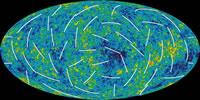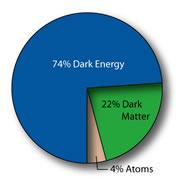 WMAP's new, more detailed picture of the infant universe. Red patches indicate warmer spots, blue patches cooler ones. The white bars show the polarization direction of old light.Credit: NASA/WMAP Science Team
WMAP's new, more detailed picture of the infant universe. Red patches indicate warmer spots, blue patches cooler ones. The white bars show the polarization direction of old light.Credit: NASA/WMAP Science TeamResearchers have released the first data in three years from a NASA satellite that is mapping the faint afterglow of the Big Bang. The much anticipated results support the idea that our Universe contains a good chunk of 'dark' material, and fits the theory that it expanded rapidly in its first moments.
The Wilkinson Microwave Anisotropy Probe (WMAP) was launched in 2001 to study the radiation left behind when the energy of the Big Bang condensed into matter. This happened about 400,000 years after the Universe was born and so the radiation, known as the cosmic microwave background, bears the imprint of the baby Universe's structure.
The results, announced by WMAP principal investigator Charles Bennett on 16 March, support the strange theory that we live in a Universe dominated by invisible dark matter and dark energy, a force that drives space to expand.
"This idea that the universe is 74% dark energy and 22% dark matter is really crazy; it relates to nothing we can measure on Earth," says Sean Carroll, a cosmologist at the University of Chicago, Illinois, who is not part of the WMAP team. "Every time we get observations that say 'Yes, the model is still working', we are surprised."
The project has also revealed the first all-sky maps of the polarization of the microwave background, which provide information about the Universe's first stars and about the rapid expansion of space-time immediately after the Big Bang.
Firmer figures
 The idea that dark material makes up so much of the Universe is "really crazy", say physicists, but the model still seems to work.Credit: NASA/WMAP Science Team
The idea that dark material makes up so much of the Universe is "really crazy", say physicists, but the model still seems to work.Credit: NASA/WMAP Science TeamResults from WMAP's first year in space were unveiled with much fanfare in February 2003. The satellite produced a full-sky map of temperature fluctuations in the background, and astronomers used it to deduce details of the Universe's age, shape and composition. Since then, the WMAP team has been working on an analysis that comprises the original data and two further years of observation.
This analysis has taken a long time to arrive, which made some people suspicious. "People were thinking either 'Boy, this is really hard' or 'They've discovered something amazing'," says Carroll. In fact it has brought few surprises, mostly firming up earlier findings.
The team says, for example, that the age of the Universe (13.7 billion years old) can now be calculated to within 60 million years rather than 200 million. And there are stronger hints than in 2003 that the Universe did indeed inflate rapidly at its birth.
The polarization maps suggest that the first stars switched on around 400 million years after the Universe was created. The microwave background became polarized as it passed through regions of ionized gas, where the stars' intense light had stripped electrons from the interstellar atoms. Knowing about this interaction will make measurements of cosmological quantities more precise, say physicists.
In addition, some confusing data points from the first survey now look like they were an experimental oddity. "There were a couple of glitches in the older data that made us worry and they've gone away," says Carroll. The WMAP team has submitted its results to The Astrophysical Journal.
Gruesome detail
ADVERTISEMENT
So why did the analysis take so long? "It was gruesome detail day after day," says Bennett. "This was an enormous undertaking, I know people were anxious and wondered why we didn't put it out straight away, but they have no idea."
Lyman Page of Princeton University led the WMAP polarization analysis. He points out that the team had to work out how each source of noise in the measurement was related to every other, and then write the analysis software from scratch.
"I think it took us all a while to even think about this in the right ways," says Page.
Visit our probebacksupdark_view.html">newsblog to read and post comments about this story.
